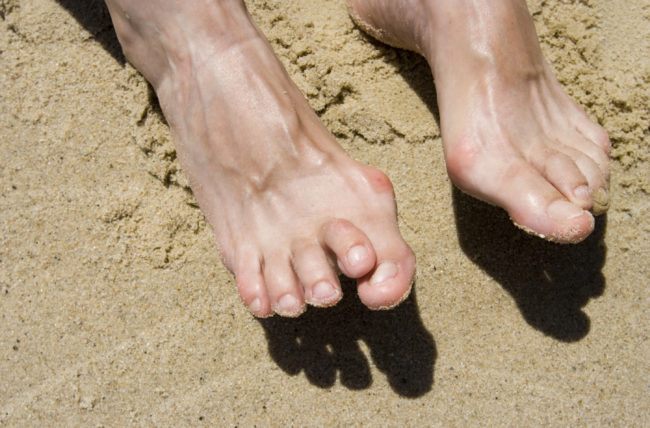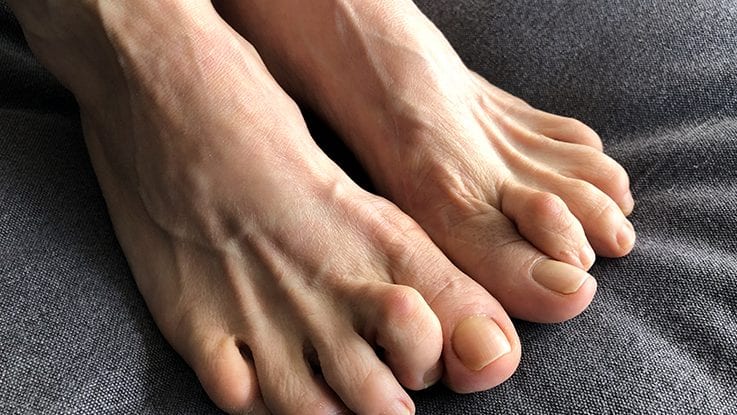A hammer toe is a deformity of the second, third or fourth toe. In this condition, the toe is bent at the middle joint, so that it resembles a hammer. Initially, hammer toes are flexible and can be corrected with simple measures but, if left untreated, they can become fixed and require surgery. Pressure from the patient’s shoe will develop a corn on the raised portion of the toe.
About Hammer Toes
The forefoot is made up of five toes. Each toe has three joints—except for the first (big) toe, which usually has only two joints. In hammer toe, the affected toe is bent at the middle joint, which is called the proximal interphalangeal (PIP) joint.
Hammer toe is the result of a muscle imbalance that puts pressure on the toe tendons and joints. Muscles work in pairs to straighten and bend the toes. If the toe is bent in one position long enough, the muscles and joints tighten and cannot stretch out.
A hammer toe is painful, especially when the patient is moving it or wearing shoes. Other symptoms may include:
- Swelling or redness
- Inability to straighten the toe
- Difficulty walking
- A corn or callus on the top of the middle joint of the toe or on the tip of the toe
Tests for Hammer Toes:
X-rays. X-rays provide images of dense structures, such as bone. Your doctor may order an x-ray of your foot to confirm the diagnosis.
Other tests: Patients who have diabetes or decreased sensation in their feet may require further testing to determine whether a neurological condition is the cause of the tendon imbalance.
 Nonsurgical Treatment for Hammer Toes:
Nonsurgical Treatment for Hammer Toes:
In the early stages of hammer toe when the joint is still flexible treatment typically consists of simple measures.
Changes in footwear:
Your doctor will recommend that you avoid wearing tight, narrow, high-heeled shoes. Shoes should be one-half inch longer than your longest toe—which, for many people is the second toe—and have a soft, roomy toe box. You may also be able to find a shoe with a deep toe box that accommodates the hammer toe. A shoe repair shop may be able to stretch a toe box so that it bulges out around the toe. Wearing sandals may help if they do not pinch or rub other areas of the foot.
Orthotic Devices:
Custom shoe inserts made by your podiatrist may be useful in controlling foot function. An orthotic device may reduce symptoms and prevent the worsening of the hammer toe deformity.
Exercises:
Specific exercises can help stretch and strengthen the muscles in your foot. Your doctor may recommend gently stretching your toes manually or using your toes to pick things up off the floor. He or she may also recommend doing “towel curls” to strengthen the toes. To perform a towel curl, place a towel flat under your foot and use your toes to crumple it.
Over-the-counter remedies:
Using commercially available straps, cushions or nonmedicated corn pads can help relieve pain. If you have diabetes, poor circulation, or a lack of feeling in your feet, talk to your doctor before attempting any self-treatment.
Surgical Treatment for Hammer Toes:
If the toe joint is rigid and no longer moveable, or if nonsurgical treatment does not relieve your symptoms, your doctor may recommend surgery. Surgery is typically performed on an outpatient basis using a local anesthetic. The actual procedure will depend on the type and extent of the deformity.
Tendon lengthening:
For patients with a flexible toe joint, the condition can often be treated by lengthening the tendons that are causing the joint imbalance.
Tendon transfer:
Some patients with a flexible toe joint may benefit from treatment that involves transferring tendons from the bottom of the toe to the top of the toe to help pull the joint into a straight position.
Arthrodesis:
Arthrodesis is a joint fusion. Patients who have a rigid toe joint may undergo tendon lengthening in combination with arthrodesis. In this procedure, your doctor will remove a small part of a bone in the toe joint to ensure that the toe can extend fully. He or she will then insert an external wire or pin and/or internal plate to hold the bones in place while the bones fuse together.
Recovery:
After surgery, you may experience some stiffness, swelling and redness in your toe for up to 4-6 weeks. Although you will be able to put pressure on the foot immediately after surgery, you should try to limit your activity while the toe heals. Elevating your foot as much as possible will help speed up healing and reduce pain. Once healed, your toe may be slightly longer or shorter than it was before.
Fortunately, hammertoe if caught early can be reversed. Some simple treatments include splinting the toe to keep it straight or stretching the tendons of the foot. Also, you can try using over-the-counter pads, cushions or straps to decrease discomfort.
Looking for an Experienced NJ Podiatrist to Treat Your Hammer Toe Issues
Are you looking for a NJ foot and ankle specialist to help with your bone spurs? Dr. Manooj Prasad at Garden State Foot & Ankle Group of Toms River is a highly-experienced podiatrist with an ardent mission to help those suffering from foot, ankle, and lower leg issues. He offers personalized care while considering each patient’s individual lifestyle needs so that the best possible treatment can be administered. Based in both Essex County and Ocean County in New Jersey, service towns include Toms River, Belleville, Roseland, Point Pleasant, Cedar Grove, Pine Beach, Millburn, Short Hills, Ocean Gate, Lakehurst, Jackson, Montclair, and many more! For more information, you can contact us today at (732)557-9900 (Toms River) 973)450-3035 (Belleville) or explore our website.
.

0 Comments